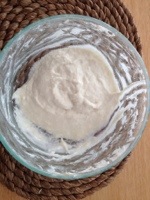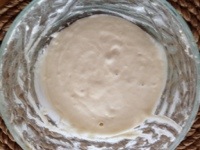I got mine from a friend who got his from Tasmania. Before that I tried making my own starter, but the flavour wasn’t great. Emily Buehler’s method involves leaving organic rye flour paste to ferment, and hoping that after a few weeks it settles to a good equilibrium. This is not guaranteed. I’ve seen a TV cook prepare a sourdough starter in a few hours, but that is far from my experience of what’s involved.
However you get your starter, you will need to keep it going. A typical regime involves taking the majority of the starter for a batch of bread, then feeding the remainder with fresh flour and water, and leaving it to ferment. How cold you keep it depends on how often you want to use it. For weekly or twice-weekly breadmaking, you leave your starter mainly in the fridge, but if you were making bread daily you would leave it out at room temperature. You can leave it for a couple of weeks in the fridge if you’re away, but beyond that it’s probably best to leave a bit with a friend who will mind it.
The volumes are entirely up to your convenience; how much you will need for a batch of bread, and how much you want to throw away at each feeding. For me about 70 mL of flour added to a scant tablespoon of culture, with water to make a paste, is a good size.
A small (500 mL) glass bowl with a lid is ideal for keeping the starter. You don’t have to wash it each time, just give the sides a good scrape occasionally, especially if they get furry, as a fungal invasion can risk the culture. As you can see, sourdough is not for germaphobes, only wishful thinking can pretend that you don’t have a living culture of useful microbes on the go. However I have never heard of a harmful culture and I guess your nose would tell you something is wrong before you got to eat it.
Some say that the wetness of the starter influences the bread flavour, and a wetter starter gives a sourer result. I keep mine as a paste. Chlorinated tap water does seem to inhibit growth, so I only use filtered tap water or water that has stood for a day or so (second option). Rainwater would be great if you have it.
For me, I love the self sufficiency of keeping a starter and the quality of the bread. On the other hand, yeast sachets are convenient and cheap, and I’ve always got some on hand for the other types of bread.
Sunday, April 28, 2024
Recent posts


